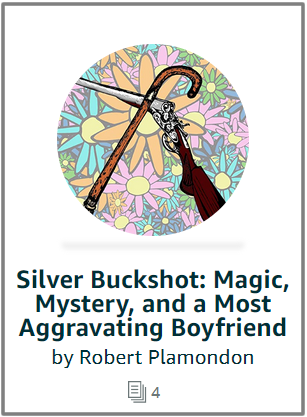
Writers new to the fiction racket are often confused about first principles. And why hot? First principles are rarely stated fair and square. Or at all.
Here’s one: You can write fiction as if it’s a true story. You can write it as if it’s a fake story. It makes a difference.
Some stories are obviously made up. You can tell from the first few words: “A guy walks into a bar.” “Once upon a time.” Others are more subtle. Some stories are obviously true. And some that aren’t true look and feel as if they are.
This appearance of truth buys you things worth having.
How People Tell Real Stories
The world is awash in published true stories: things that actually happened and are told truthfully, more or less. And you know what? If written halfway competently, truth has the ring of truth about it! Not because of what it says, but the way it says it. In this sense, truth is stronger than fiction. We can use that.
When you say something that rings true, the audience unconsciously accepts it, building up a bit of credibility and letting the audience sink deeper into the story. The next time you say something hard to believe, you can coast on through without overdrawing your credibility account.
So: how do people tell real stories? You can take a look at your favorite true-life adventures to find out. You’ll discover that there are pretty much two methods. One looks like third-person omniscient narration and the other looks like traditional first-person narration. Both forms openly use a narrator to tell readers what they need to know.
Let’s spend a moment on how these two narrative forms are used in nonfiction.
Third-Person Narration
Take the example of a journalist or historian who has studied an event and knows a lot about it. Perhaps they interviewed the surviving participants, read contemporary reports, diaries, and letters, studied the maps, visited the locations, and so on. They can tell you what happened and often what the characters were thinking. They work around the gaps in their knowledge or fill them with plausible guesswork.
The natural inclination is to write the story from the third-person omniscient point of view. The research that revealed different points of view makes it natural and convenient to tell it that way, narrating the facts through direct exposition and handling the personal experiences of individual characters more intimately. Converting the story into something more stream-of-consciousness-y can certainly be done, but it involves more invention, which makes our true story less true. Handle with care.
Histories, biographies, myths, true crime stories, and many others are typically told this way. Random examples from my library include The Dillinger Days by John Toland and Cod: A Biography of the Fish that Changed the World by Mark Kurlansky.
Really big histories tend to force the writer into third-person narration: the four-volume History of the English-Speaking Peoples by Winston S. Churchill, for instance. On the other hand, William L. Shirer’s massive The Rise and Fall of the Third Reich is partly in first-person because he actually witnessed many of the more public events before the war got rolling, since he was working as a journalist covering European politics at the time.
Omniscient Narrators Aren’t Very Omniscient
Beginning writers tend to trip over the word “omniscient” in “third-person omniscient narration.” Such narrators don’t have to be godlike at all, and usually aren’t. They’re just well enough informed to tell the story with confidence. That’s it. Confidence, not omniscience.
Nor does the omniscient narrator have to be objective or detached from their subject, which is just as well. Nothing’s more useless than a narrator who doesn’t care. Nonfiction tales that do well have authors sharing their love of the topic and its characters. Their well-informed enthusiasm is what brings the topic to life.
First-Person Narration
A well-informed but thoroughly human narrator is also typical of first-person memoirs. You can rattle off what happened with confidence because you were there, and with passion and understanding because you were there. What you can’t remember, you can reconstruct more or less accurately because you were there.
The first few times someone tells a recent real-life adventure out loud, they haven’t had the time to make it fancy in big ways, though if they have the gift of gab it might sparkle in small ways. It’s almost always told in the past tense because it happened in the past. In spite of digressions and backtracking, the intention is to tell it simply and clearly, letting the events do the heavy lifting, not storytelling techniques, though, being only human, the storyteller lingers on the good parts to get what effect they can.
Retelling the story will polish it, and time provides the benefit of hindsight as the author learns things they didn’t know at the time and gains a perspective they didn’t have then. There’s generally no reason to conceal this, so the author doesn’t.
Copying Techniques From True Stories
With true stories, it’s obvious that the story is being told by a storyteller; that is, the author wrote it down so you could read it. We all know this and there’s no point concealing it, so no one does.
Exposition
Take exposition. With nonfiction tales, when the reader needs to know something, the author tells them, simply and directly, in their own voice. (We’ll come back to voice in a minute.) They might give you the background in dribs and drabs at the last possible moment or they might gather it together and give it to you all at once. Pick your poison.
With fiction, though, we have the option of using more restrictive viewpoints, ones where we pretend there is no independent narrator. Instead, the story is telling itself (or something).
Without an independent narrator, no one can tell the readers what they need to know when they need to know it. Instead, the readers have to wait until the information is revealed to the viewpoint character. When the viewpoint character sees, hears, or thinks something, the readers get to read about it. Otherwise, they’re out of luck. Even if the viewpoint character knows all about it, these restrictive viewpoints hide it from the reader until the knowledge moves to the forefront of the viewpoint character’s mind. Stream-of-consciousness is like that, and so is third-person limited, at least the way some people do it.
This is why characters tell each other things they already know: it’s so the readers can hear the information. It’s why characters look at themselves in mirrors and take in their reflection as if they’d never seen it before. It’s so the readers can see them. It’s why they think about things that (to them) are obvious as if they’d never thought about them before. It’s so the readers can hear their thoughts.
In other words, the characters say, do, and think things that are out of character; they’re doing the narrator’s job as well as their own! This is a tricky way to write fiction. It can be done, and done well, but I’m surprised anyone thinks such modes are suitable for beginners.
You don’t see this much with nonfiction, because instead of telling a true story fair and square, it has an extra layer of artifice.
Narrative Voice and Viewpoint
Let’s take a look at True Grit by Charles Portis (the book, not the movies). This is told as a first-person reminiscence by Mattie Ross, who was fourteen years old during her adventure but didn’t write the story down until many years later, after she learned that Rooster Cogburn was dead. It had been the one great adventure of her life, and now no one remembered it but her. Soon no one would know that it had ever happened.
In short, the story was written from a dual perspective: that of the girl she had been and that of the older woman she had become. The two were very different and very much the same.
Leon Portis’ voice never appears at all. It’s all in Mattie Ross’ voices, old and young.
Carefully crafted narrative voices are also used in third-person fiction. If you haven’t read it already, take a look at the first volume of Lemony Snicket’s A Series of Unfortunate Events, where the author constructs Lemony Snicket not just as a pseudonym, but as a strange and quirky character, an “intrusive narrator” who constantly draws attention to himself, interrupting his own story to achieve different effects.
 In my own first-person fiction, such as my ongoing serial adventure Silver Buckshot: Magic, Mystery, and a Most Aggravating Boyfriend, my first-person viewpoint characters write down their adventures as soon as the dust settles. I want them to have essentially the same attitude and level of maturity during the adventure and when they write it down. The sad nostalgia of True Grit is fine if that’s what you want, but I’m going for a more unified viewpoint.
In my own first-person fiction, such as my ongoing serial adventure Silver Buckshot: Magic, Mystery, and a Most Aggravating Boyfriend, my first-person viewpoint characters write down their adventures as soon as the dust settles. I want them to have essentially the same attitude and level of maturity during the adventure and when they write it down. The sad nostalgia of True Grit is fine if that’s what you want, but I’m going for a more unified viewpoint.

In my third-person fiction, such as my science-fiction thriller One Survivor, the narrator doesn’t intrude enough for you to know much about them, but I know. I characterize my third-person narrators, not only to give them a voice tailored for the occasion but to give them known perspectives and attitudes, though I rarely share this information directly with the reader.
In true-life stories, of course, the narrative voice isn’t a made-up character: it’s the author’s, though probably more formal than they’d be in conversation or an email, maybe too formal. We’re taught in grade school that using our vocabulary words earns us praise, and until we unlearn this we tend to err on the side of Brobdingnagian grandiloquence.
Final Thoughts
So what does all this add up to?
But First, a Joke
A guy named Fred is sent to prison. During lunch on his first day, a prisoner stands up, waits for silence, and says, “Number 37.” Everyone bursts out laughing.
Fred asks his neighbor, “What was that?”
“You see, the prison library only has one joke book and we’ve all read it a million times. Somebody numbered all the jokes in pencil, and if you say the number, we remember the joke and laugh.”
Fred checked out the book and studied it diligently. When he was ready, he stood up at lunchtime, waited for silence, and said, “Number 63.”
Dead silence. Crestfallen, he sat down and asked his neighbor. “That was the best joke in the book! What went wrong?”
“It’s not the joke so much, but how you tell it.”
It’s the Story
But real storytelling isn’t like that. Fiction authors hear about all sorts of narrative techniques and assume that successful writing is about beautiful or clever prose. They hear about the three-act or five-act or seven-act structure, the seventeen steps of every story, the thirty-seven master plots, fifty ways to leave your lover, and all that jazz.
All that stuff is secondary.
The main thing is to find a story that readers will enjoy reading even if you tell it badly, then tell it better than that.
A true story can be told with clever narrative techniques and beautiful prose. And you can divide it into acts and follow the seventeen steps and apply one of the thirty-seven master plots—provided you don’t turn the story from something real into something fake. Many of these are useful. But only the essence is essential.
Master stylists—a group of people I define as “neither of us is a master stylist”—can do a lot with stories that are seemingly content-free and not stories at all. They are more to be admired than imitated, at least not yet.
The underlying story is the essential part. The underlying story of Rapunzel isn’t the Disney animated version specifically, nor the one in Grimm’s Fairy Tales. It’s the setting, characters, and action of the story, not its expression.
Our task as storytellers is to hold the readers enthralled all the way to the end and make them yearn for a sequel. Achieving this requires that we do a number of different things reasonably well, but the story needs to be there or it’s all for nothing.
Fortunately, coming up with such a story isn’t impossible. Difficult, yes, but not that difficult. See my article on the Lester Dent Method. Dent was a prolific pulp author, the creator of Doc Savage, and pulp authors found ways to invent new stories quickly and reliably.
Once you have an underlying story that’ll carry the reader along, let it. Don’t pay too much attention to what you learned about telling a hypothetical story. Tell this specific story in the most impactful way you can, using or ignoring techniques depending on what works. Let your words reveal the story. Don’t let them get in the way.
If you can experience the underlying story yourself, to the point where it’s true on some level—vividly and emotionally true, not literally true—and not a mechanical contrivance, you can speak its truth to the reader and be believed.
